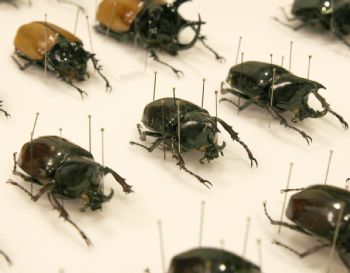Kingdom Animalia Trivia Quiz
(145).jpg)
.
Questions and Answers
- 1.
Which of these animals is an echinoderm?
- A.
Starfish
- B.
Roundworm
- C.
Elephant
- D.
Sponge
Correct Answer
A. StarfishExplanation
Starfish is the correct answer because it is an echinoderm. Echinoderms are a group of marine animals characterized by their spiny skin and radial symmetry. Starfish, also known as sea stars, belong to this group and exhibit all the typical characteristics of echinoderms. They have a central disc-shaped body with multiple arms extending from it, and their body is covered in spines. Starfish are found in oceans around the world and play important roles in marine ecosystems.Rate this question:
-
- 2.
An earthworm belongs to which phylum?
- A.
Arthropoda
- B.
Porifera
- C.
Annelida
- D.
Cnideria
Correct Answer
C. AnnelidaExplanation
An earthworm belongs to the phylum Annelida because this phylum includes segmented worms, such as earthworms, leeches, and marine worms. Annelids are characterized by their elongated and segmented bodies, with each segment containing a set of organs. They have a closed circulatory system and a well-developed nervous system. Earthworms, specifically, are known for their important role in soil health and nutrient cycling. They are hermaphroditic and play a crucial role in breaking down organic matter in the soil, making them essential for the ecosystem.Rate this question:
-
- 3.
Which phylum does this animal belong in?
- A.
Platyhelminthes
- B.
Amphibia
- C.
Mollusca
- D.
Arthropoda
Correct Answer
D. ArthropodaExplanation
The correct answer is Arthropoda. Arthropoda is a phylum that includes animals with jointed appendages, segmented bodies, and an exoskeleton. This animal is likely to belong to this phylum because it exhibits these characteristics. Platyhelminthes is the phylum of flatworms, Amphibia is the phylum of amphibians, and Mollusca is the phylum of mollusks, none of which match the characteristics described.Rate this question:
-
- 4.
Which of these choices do an octopus and a clam have in common?
- A.
They are both filter feeders.
- B.
They are both molluscs.
- C.
They both have an exoskeleton.
- D.
They both have chromatophores.
Correct Answer
B. They are both molluscs.Explanation
Octopuses and clams are both molluscs. Molluscs are a large phylum of invertebrate animals that include creatures such as snails, clams, octopuses, and squids. They share certain characteristics such as a soft body, a muscular foot for movement, and a mantle that secretes a shell in some species. While both octopuses and clams are molluscs, they differ in many other aspects. Octopuses are cephalopods, known for their intelligence and ability to change color, while clams are bivalves, known for their two-part hinged shells.Rate this question:
-
- 5.
Some members of this phylum have radial symmetry.
- A.
Nematoda
- B.
Porifera
- C.
Cnideria
- D.
Vertebrata
Correct Answer
C. CnideriaExplanation
Members of the phylum Cnideria, such as jellyfish and sea anemones, have radial symmetry. This means that their body parts are arranged around a central axis, like the spokes of a wheel. This allows them to interact with their environment from all directions equally. Nematoda, Porifera, and Vertebrata do not have radial symmetry, making Cnideria the correct answer.Rate this question:
-
Quiz Review Timeline +
Our quizzes are rigorously reviewed, monitored and continuously updated by our expert board to maintain accuracy, relevance, and timeliness.
-
Current Version
-
Mar 22, 2023Quiz Edited by
ProProfs Editorial Team -
May 04, 2010Quiz Created by
Becksci
Harry Potter House Quiz: Which Hogwarts House Do You Belong To?
Harry Potter House Quiz: Which Hogwarts House Do You Belong To?
Grammar Mastery: A Quiz on Simple, Compound, and Complex Sentences
Grammar Mastery: A Quiz on Simple, Compound, and Complex Sentences
- Amphibian Quizzes
- Bird Quizzes
- Cat Quizzes
- Dinosaur Quizzes
- Dog Quizzes
- Emperor Penguin Quizzes
- Endangered Species Quizzes
- Fish Quizzes
- Goat Quizzes
- Hamster Quizzes
- Horse Quizzes
- Insect Quizzes
- Invertebrate Quizzes
- Mammal Quizzes
- Mouse Quizzes
- Nematode Quizzes
- Pet Quizzes
- Pig Quizzes
- Rabbit Quizzes
- Reptile Quizzes
- Sheep Quizzes
- Wolf Quizzes
- Zoo Quizzes
 Back to top
Back to top



